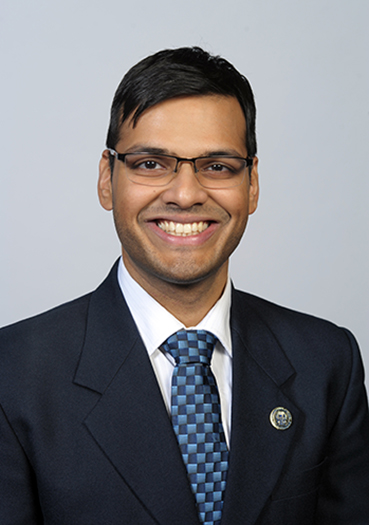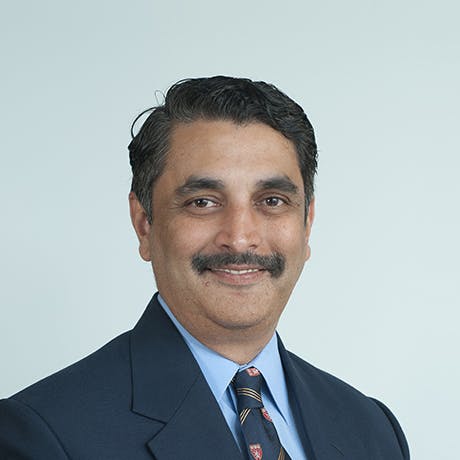Robotic-Assisted Laparoscopic Paraesophageal Hiatal Hernia Repair with Fundoplication and Esophagogastroduodenoscopy
Main Text
Table of Contents
A hiatal hernia occurs when part of an intra-abdominal organ, most commonly the stomach, migrates through the diaphragmatic crura. The condition can cause a range of uncomfortable symptoms, including heartburn, chest pain, and difficulty swallowing. While several individuals with a hiatal hernia can manage their symptoms with lifestyle changes and anti-reflux medications, some with refractory symptoms or complications secondary to the hernia require surgical treatment to repair the defect. Here we present the case of a 60-year-old female with a paraoesophageal hiatal hernia and chronic gastrointestinal reflux disease (GERD) refractory to proton-pump inhibitors (PPI), dietary changes, and lifestyle modifications. She underwent an elective robotic hiatal hernia repair, fundoplication, and esophagogastroduodenoscopy (EGD) as a two-hour procedure with routine postprocedure recovery. This article and the associated video describe the pertinent history, evaluation, and operative steps of the procedure.
Hiatal hernia repair; paraoesophageal hernia; fundoplication; GERD.
Hiatal hernias affect approximately 10–50% of the adult population worldwide, representing a relatively common medical and surgical problem.1 Hiatal hernia is defined as the migration of the stomach (a portion or all of it), or other abdominal organs, through a defect in the diaphragmatic crura into the mediastinum. Symptoms can be caused by gastroesophageal reflux disease (GERD), obstruction, bleeding from ulceration, or iron deficiency anemia. If the gastroesophageal junction (GEJ) is obstructed due to volvulus or twisting of the stomach, it can cause severe dysphagia and regurgitation. Gastric outlet syndrome is commonly accompanied with nausea, emesis, and epigastric pain.
Based on the anatomy and pathophysiology, hiatal hernias can be classified into one of four types. The sliding hiatal hernia (type 1) is the most common, and accounts for roughly 90% of all hiatal hernias in the US. They involve the migration of the GEJ into the mediastinum. A type 2 hiatal hernia has the GEJ at the expected anatomical position; however, a portion of the stomach migrates through the diaphragmatic crura. A type 3 hiatal hernia also has a portion of the stomach herniated through the hiatus; however it also has an abnormal position of the GEJ. Type 4 hernias have an abnormal GEJ position and also involve another organ, most commonly part of the colon, herniated through the hiatus into the thoracic cavity.2
Surgical treatment for hiatal hernias is indicated for sliding hernias with GERD refractory to medical management with medications and lifestyle modifications, as well as for paraoesophageal hernias prone to prolapse or with gastric volvulus, ulceration, or stenosis.3
Our patient is a 60-year-old overweight female with a BMI of 30 who presented with a paraoesophageal hiatal hernia and GERD refractory to medications and lifestyle modifications for five years. Her other relevant past medical history included hypertension, asthma, and a history of unprovoked pulmonary emboli. The patient’s past surgical history was notable for an endometrial ablation, and a laparoscopic bilateral salpingo-oophorectomy.
Over the five years preceding the patient’s presentation, she had symptoms of gastric reflux, including epigastric pain and retrosternal burning. Her epigastric pain had worsened over the past 6 months and resulted in semi-voluntary emesis. She also has had regurgitation of food that with worsening frequency, from once a month to now once per week over the past three months. She was taking omeprazole daily, and although her symptoms initially improved, her heartburn persisted and became nonresponsive to the PPI therapy.
She underwent an esophagogastroduodenoscopy (EGD) preoperatively for a thorough examination of the gastrointestinal tract, which demonstrated a 6-cm hiatal hernia and an irregular Z-line, 34 cm from the incisors. The GEJ biopsy pathology demonstrated squamocolumnar junctional mucosa with mild chronic inflammation and reactive changes.
Given the patient's persistent symptoms of GERD that were refractory to medications, unintentional weight loss, inability to tolerate regular food, and intermittent odynophagia, she elected to opt for a robotic hiatal hernia repair with Nissen fundoplication. Risks and benefits of the procedure were explained and well understood by the patient.
A focused physical examination in this case was performed with the patient in supine position. The patient was afebrile with stable and normal vital signs. Neurologically the patient was alert and oriented to person, place, and time. Her neck was noted to be supple, and trachea midline. Her breathing was unlabored on room air with normal respiratory effort. Her abdomen was soft, nontender, and nondistended. And lastly, her extremities were warm and well perfused, with symmetric and palpable radial pulses bilaterally.
The patient’s complete blood count and electrolytes were within normal limits. A barium swallow esophagram was obtained, which demonstrated a 6-cm hiatal hernia with spontaneous, large volume gastroesophageal reflux into the cervical esophagus. Esophageal manometry and pH monitoring were also performed, and notable for a hypotensive lower esophageal sphincter.
The patient was brought to the operating room, positioned in supine position and given general anesthesia with an endotracheal tube. After performing a safety timeout, we proceed with sterile preparation and draping the abdomen. Pneumoperitoneum was achieved with the supraumbilical 10-mm incision with a direct open Hassan technique followed by insertion of an 8-mm port. Under direct vision another 8-mm port, one 5-mm port, and one 12-mm port were introduced into the abdomen. The right lateral 5-mm port was used to introduce the liver retractor to retract the left lobe of the liver anteriorly and expose the hiatus.
Next, we dock the robot in the standard fashion and achieve targeting in the standard fashion. We appreciate a large hiatal hernia, which was then partially reduced with a hand-over-hand technique using two atraumatic graspers. The gastrohepatic ligament was then identified at the pars flaccida level and was taken down with a robotic energy device to expose the right crus of the diaphragm. We then continue dissection along the right crus circumferentially and down the left crus towards the spleen. The fascia over the crus was carefully preserved. Next, a plane is created between the right crus and the hernia sac, and subsequently between the sac and the left crus.
The gastrosplenic ligament is identified, and the fundus of the stomach is mobilized by taking down the short gastric vessels with the help of a robotic energy device. This ensures that the entire fundus of the stomach is mobilized even posteriorly near the left crus.
A plane was then created between the left crus and the hernia sac to enter the lower mediastinum. We then continued the dissection in the proximal mediastinum to free up the hernia sac from the surrounding mediastinal structures including the pleura, pericardium, and aorta. The dissection is continued towards the apex and down the right crus to completely mobilize the sac along with the hernia contents. The right crus is completely defined and the junction of the right and left crus posterior to the esophagus is dissected. Hemostasis is continually achieved throughout these maneuvers. We then create a plane anterior to the left crus posterior and behind the esophagus by lifting the esophagus superiorly to position the fundoplication appropriately. After defining the sac posterior to the esophagus and freeing it up from the right and left crura preserving the vagus nerves, the sac along with its contents is completely reduced inside the abdomen. The hiatus is then clearly defined and closed with continuous 0 non-absorbable V-Loc sutures using a horizontal mattress technique. During the hiatal closure, care is taken to leave a small opening to prevent postoperative esophageal obstruction.
At this time, the angle of His is completely and clearly defined by a marking stitch approximately 6 cm from the GEJ laterally towards the spleen on the fundus of the stomach. A 360-degree fundoplication is then performed, and the wrap is sutured to the left crus with a single interrupted suture to prevent migration.
The operative area is irrigated with a mix of normal saline and local anesthetic, and an EGD is done to visualize the patency of the repair and successfully rule out any other pathology. The EGD also helps evaluate the correct creation and orientation of the wrap on retroflection. The stomach and the duodenum were suctioned out and the gastroscope removed. The robot is then undocked, and the laparoscopic camera is used for the next steps. The liver retractor is removed after confirming hemostasis. The 12-mm port is closed with endoscopic fascial closure device. All the other ports are then removed after injecting local anesthetic at the ports’ sites. The fascia at the supraumbilical site is closed with 0 Vicryl stitch in a figure-of-eight manner. Skin was closed at all port sites with 4-0 Monocryl sutures.
Finally, the patient is extubated and shifted to the postoperative recovery room in a stable condition. Blood loss during this case was minimal, and there were no specimens sent.
Other surgical techniques that could have been used for this hiatal hernia repair include open and laparoscopic approaches, both with or without fundoplication, including LINX devices. Our choice of a robotic hiatal hernia repair with fundoplication through an abdominal approach over the other options was primarily motivated by a combination of patient preference, surgeon experience, and improved postoperative clinical outcomes.
Laparoscopic hiatal hernia repair has been favored over open hiatal hernia repair for many years. Research has shown that laparoscopic repair results in lesser blood loss, fewer intraoperative complications, and a shorter length of hospital stay.4 More recently, robotic hiatal hernia repair has gained favor over a laparoscopic repair in certain specialized centers. When analyzing 7 years of robotic experience for hiatal hernia repairs, robotic repair was shown to be associated with a significantly shorter length of stay when compared to laparoscopic repair. For patients with at least 1 year of follow-up, recurrence rates were lower after a robotic repair.5
Hiatal hernia repair can be accomplished through a thoracic or abdominal approach. When compared to an abdominal approach, thoracotomy is associated with prolonged hospital stay, increased need for postoperative mechanical ventilation, and increased rate of pulmonary embolism.6
Fundoplication has also been standard for hiatal hernia repairs. Studies have demonstrated that fundoplication prevents postoperative acid reflux by restoring the lower esophageal sphincter competency. In addition, fundoplication also prevents recurrence by anchoring the stomach below the diaphragm.7 In select conditions, gastropexy may also be useful depending on intraoperative findings. In this case, our patient was seen at follow-up in clinic, and at the 2-month timepoint, denied any symptoms of gastric reflux or regurgitation.
Hiatal hernia repair with fundoplication is a very common elective procedure for patients presenting with a symptomatic hiatal hernia and GERD refractory to non-operative management. Here we described a robotic-assisted hiatal hernia repair with 180-degree fundoplication, followed by EGD to rule out pathology or leaks. The patient underwent general anesthesia, and the procedure had minimal blood loss and no complications. Patient’s diet was advanced to full liquids on postoperative day one and her pain was controlled with oral medications. She was discharged home without services on postoperative day two in stable condition. Postoperatively, two months after surgery, the patient was noted to have resolution of the symptoms of acid reflux and regurgitation.
A robotic-assisted hernia repair with fundoplication should be considered as an elective option for hiatal hernia repair in patients with symptomatic sliding or paraoesophageal hernias. Robotic-assisted procedures have shown to decrease length of stay and recurrence rates,5 and fundoplication has also demonstrated to reduce acid reflux postoperatively as well as decrease rates of recurrence.7-9
No special equipment, tools, or implants used in the procedure.
No relevant disclosures of conflicts of interest.
The patient referred to in this video article has given their informed consent to be filmed and is aware that information and images will be published online.
We thank the patient for giving us the permission to present this case in JOMI.
References
- Dean C, Etienne D, Carpentier B, Gielecki J, Tubbs RS, Loukas M. Hiatal hernias. Surg Radiol Anat. 2012;34(4):291–9. doi:10.1007/s00276-011-0904-9.
- Watson TJ, Moritz T. Sliding Hernia. [Updated 2022 Jul 18]. In: StatPearls [Internet]. Treasure Island (FL): StatPearls Publishing; 2023 Jan-. Available from: https://www.ncbi.nlm.nih.gov/books/NBK459270/.
- Takeuchi N, Nomura Y. Paraesophageal hernia with incarceration of the gastric antrum and duodenal bulb: a case report. BMC Res Notes. 2013;6:451. doi:10.1186/1756-0500-6-451.
- Ferri LE, Feldman LS, Stanbridge D. et al. Should laparoscopic paraesophageal hernia repair be abandoned in favor of the open approach?. Surg Endosc. 2005;19:4–8. doi:10.1007/s00464-004-8903-0.
- O’Connor SC, Mallard M, Desai SS, et al. Robotic versus laparoscopic approach to hiatal hernia repair: results after 7 years of robotic experience. Am Surg. 2020;86(9):1083-1087. doi:10.1177/0003134820943547.
- Paul S, Nasar A, Port JL, et al. Comparative analysis of diaphragmatic hernia repair outcomes using the nationwide inpatient sample database. Arch Surg. 2012;147:607–12. doi:10.1001/archsurg.2012.127.
- Casabella F, Sinanan M, Horgan S, Pellegrini CA. Systematic use of gastric fundoplication in laparoscopic repair of paraesophageal hernias. Am J Surg. 1996;171:485–9. doi:10.1016/S0002-9610(97)89609-2.
- Lebenthal A, Waterford SD, Fisichella PM. Treatment and controversies in paraesophageal hernia repair. Front Surg. 2015;2:13. doi:10.3389/fsurg.2015.00013.
- Tartaglia N, Pavone G, Di Lascia A, et al. Robotic voluminous paraesophageal hernia repair: a case report and review of the literature. J Med Case Reports. 2020;14:25. doi:10.1186/s13256-020-2347-6.
Cite this article
Bougleux Gomes HA, Agarwal D, Paranjape C. Robotic-assisted laparoscopic paraesophageal hiatal hernia repair with fundoplication and esophagogastroduodenoscopy. J Med Insight. 2023;2023(399). doi:10.24296/jomi/399.



